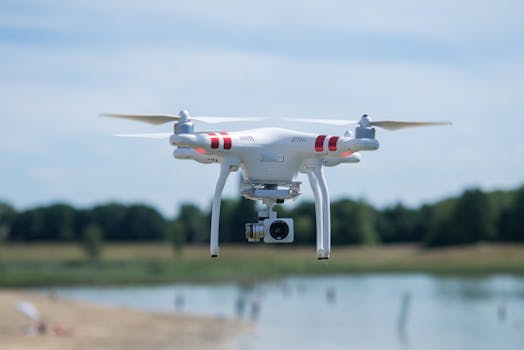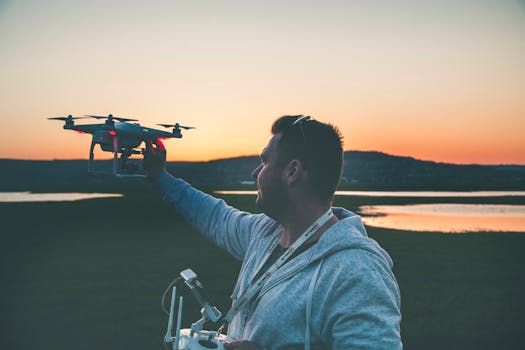DRONE
What is a robot and how do drifts work is answered here in this clear article. Machine advancement is consistently creating as new headway and gigantic hypothesis are passing on additionally created robots to the market predictably.
Underneath, we discuss UAV development on the most surely understood machines accessible which have all the latest robot advancement. Most machines will have on a very basic level the same as systems melded.
Unmanned aeronautical vehicle advancement covers everything from the ideal plan of the robot, materials in the make of the physical UAV, to the circuit sheets, chipset and programming which are the brains of the machine.
A champion among the most pervasive robots accessible is the DJI Phantom 3. This robot was to a great degree conspicuous with capable flying cinematographers. While to some degree old now, it uses a considerable measure of front line advancement which is accessible in the straightforward latest machines.
This UAV is impeccable to elucidate meander development since it has everything in one package. It joins the UAV, gimbal and camera and utilizations a part of the best machine development accessible today.
In only two or three months since creating this article, some new and exceedingly impelled machines, for instance, the DJI Mavic Air, Phantom 4 Pro, Inspire 2 and Walkera Voyager 5 have gone to the market.
The speedy pace of robot mechanical advancement is monster. I've fused these latest machine development movements in the underneath article. So this article is up and coming including all associations.
 |
| What is a Drone? |
A typical unmanned plane is made of light composite materials to reduce weight and augmentation portability. This composite material quality empowers military machines to voyage at to an awesome degree high statures.
Machines are furnished with different front line advancement, for instance, infra-red cameras (military UAV), GPS and laser (military UAV). Machines are controlled by remote control structure in like manner from time to time suggested as a ground cockpit.
An unmanned raised vehicle system has two areas, the machine itself and the control structure.
The nose of the unmanned raised vehicle is the place each one of the sensors and navigational systems are accessible. The straggling leftovers of the body is stacked with meander advancement structures since there is no prerequisite for space to suit individuals. The outlining materials used to fabricate the robot are particularly staggering composites which can hold vibration which decreases the upheaval conveyed and besides light weight.
What Is A Drone – UAV Technology
Underneath we take a gander at the science and robot development behind the DJI Phantom 3 UAV. Regardless, we also have a great deal of information on the latest machine developments from the freshest robots accessible. There are a considerable measure of associations where you can read assist into various parts of robot advancement. For example, here is a shocking robot parts chart article. This gives you a breakdown of the individual portions seen in numerous robots.
Machine Types And Sizes
Machines touch base in a wide arrangement of sizes, with the greatest being generally used for military purposes, for instance, the Predator drift. The accompanying in assess are unmanned carrier which have settled wings and require short runways. These are generally used to cover considerable districts, working in areas, for instance, geographical investigating or to fight common life poaching.
VTOL Drones
Next in size of robots and are what is known as VTOL meanders. An extensive part of these are quadcopters anyway not all. VTOL robots can take off, fly, buoy and land vertically. The right significance of VTOL is "Vertical Take-Off and Landing".
Countless latest little machines, for instance, the DJI Mavic Air and DJI Spark can be impelled from the palm of your hand.
Radar Positioning and Return Home
A critical number of the latest machines have twofold Global Navigational Satellite Systems (GNSS, for instance, GPS and GLONASS. Machines can fly in both GNSS and non satellite modes. For example DJI machines can fly in P-Mode (GPS and GLONASS) or ATTI mode which doesn't uses satellite course.
Exceedingly exact machine course is basic when flying and in meander applications, for instance, to collect 3D maps, surving scene and SAR (Search and Rescue) missions.
Exactly when the quadcopter is first traded on, it looks and recognizes GNSS satellites. Top notch GNSS systems use Satellite Constellation advancement. On a very basic level, a satellite star gathering is a social occasion of satellites collaborating giving made degree and synchronized with the objective that they cover well in scope. Pass or extension is the period in which a satellite is observable over the adjacent horizon.
The radar development in the robot will signal the going with on the remote controller appear;
hail that enough machine GNSS satellites have been perceived and the robot is set up to fly
demonstrate the present position and region of the machine in association with the pilot
record the home point for 'Return To Home' security incorporate
By far most of the latest robot have 3 sorts of Return to Home machine advancement as takes after;
Pilot began return to home by crushing catch on Remote Controller or in an application.
Low battery level where the UAV will fly back therefore back to home point.
Loss of transmission between the UAV and Remote Controller with the UAV flying back thusly to its home point.
The latest Mavic Air RTH feature can recognize and adequately tries to keep up a key separation from impediments in the midst of customized return to home. The Mavic Air RTH obstruction avoidance fills in as takes after if the lighting is satisfactory;
The Mavic Air backs off when a block is identified
It will stop and buoy, by then fly backward and rises upwards until the point that no hindrance is distinguished.
Next the RTH methodology resumes and the Mavic Air will return to home point a the new stature.
Obstacle Detection And Collision Avoidance Technology
Various robots are as of now furnished with affect avoidance structures. These robot vision structures use obstacle acknowledgment sensors to check the earth, while programming computations and SLAM development convey the photos into 3D maps empowering the flight controller to recognize and keep up a vital separation from the dissent. These systems are merging one of a more prominent measure of the going with sensors to identify and keep up a key separation from obstacles;
Vision Sensor
Ultrasonic
Infrared
Lidar
Time of Flight (ToF)
Monocular Vision
 |
| What is a Drone? |
The latest DJI Mavic 2 Pro and Mavic 2 Zoom have deterrent identifying on each one of the 6 sides. The Mavic 2 uses both Vision and Infrared sensors joined into a fantasy structure known as Omnidirectional Obstacle Sensing.
The DJI Mavic 2 obstruction recognizing system goes to the accompanying level where it can extremely fly around deterrents in front or when flying backward. If it can't work out a flight route around the inquiry, it will then buoy before the hindrance. This is known as APAS (Advanced Pilot Assistance System) on the DJI Mavic 2 and Mavic Air meanders.
Gyro Stabilization, IMU And Flight Controllers
Gyro change advancement is one of the sections which gives the machine its smooth flight limits. The spinner needs to work instantly to the forces moving against the robot. The whirligig gives fundamental navigational information to the central flight controller.
The inertial estimation unit (IMU) works by perceiving the present rate of accelerating using no less than one accelerometers. The IMU recognizes changes in rotational attributes like pitch, roll and yaw using no less than one spinners. Some IMU join a magnetometer to help with alteration against presentation drift.
The Gyroscope is a piece of the IMU and the IMU is an essential portion of the robots flight controller. The flight controller is the central personality of the machine.
Here is a dumbfounding article which covers gyro alteration and IMU development in drifts.
Machine Motor Direction And Propeller Design
The motors and propellers are the machine advancement which get the UAV into the air and to fly toward any way or buoy. On a quadcopter, the motors and propellers work in sets with 2 motors/propellers rotating clockwise (CW Propellers) and 2 motors turning Counter Clockwise (CCW Propellers).
They get data from the flight controller and the electronic speed controllers (ESC) on the machine motor bearing to either float or fly.
Onscreen Real-Time Flight Parameters
Screen current flight telemetry and see what your machine sees on your mobile phone.
Information on what is drift development and how rambles advancement work in QuadcoptersNo Fly Zone Drone Technology
Remembering the true objective to construct flight security and balance adventitious flights in limited domains, the latest machines from DJI and distinctive creators join a "No Fly Zone" feature.
These no fly zones have been isolated into two classes: An and B. Makers can invigorate and change this no fly zone drift development using firmware revives.
GPS Ready To Fly Mode Drone Technology
Right when the compass s is adjusted, the robot by then searches for the zone of GPS satellites. Exactly when more than 6 are found, it empowers the robot to fly in "Arranged To Fly" Mode.
Internal Compass and Failsafe Function
Licenses the UAV and remote control system to know decisively its flight zone. Arrangement of the Compass is required to set a home point. The home point is the place the machine will return to if there ought to emerge an event of loss of banner between the robot and the remote control structure. This is furthermore know as "shield work".
FPV Live Video Transmission Drone Technology
FPV connotes "First Person View" and it is the place a camcorder is mounted on the unmanned aeronautical vehicle and imparts the live video to the pilot on the ground. The pilot is flying the flying machine just as they were prepared the plane instead of looking carrier from the pilot's certifiable ground position.
FPV empowers the unmanned carrier to fly altogether higher and more remote than you can from looking plane beginning from the most punctual stage. First Person View mulls over more correct flying especially around obstacles.
It furthermore thinks about unmanned airborne vehicles to fly easily inside, through timberlands and around structures where it would not be possible to fly from a settled position on the ground looking toward the robot out there.
The especially fast improvement and progression of the machine dashing class would not be possible without FPV live video transmission development.
This FPV advancement uses radio banner to transmit and get the live video.
The robot has a multi-band remote FPV transmitter worked in nearby a radio wires. Dependent upon the robot, the beneficiary of the live video signs can be either the remote control unit, a PC, tablet or mobile phone contraption.
This live video feed is related to the nature of the banner between the ground control on the robot. The latest robots, for instance, the DJI Mavic and Phantom 4 Pro, can transmit live video up to 4.3 miles (7 km). The Phantom 4 Pro and Inspire 2 use the latest DJI Lightbridge 2 transmission system.
Machines, for instance, the DJI Mavic Pro use facilitated controllers and shrewd figurings to set another standard for remote best quality picture transmission by cutting down inaction and growing most prominent range and reliability.
Live video and boosting the extent of the transmission is fascinating robot development. Read this article entitled "Understanding FPV Live Video Transmission".
FPV Over 4G/LTE Networks
In 2016, another live video which transmits over the 4G/LTE orchestrate giving a vast range and low torpidity video. This machine advancement is the Sky Drone FPV 2 and contains a camera module, a data module and a 4G/LTE modem.






ConversionConversion EmoticonEmoticon